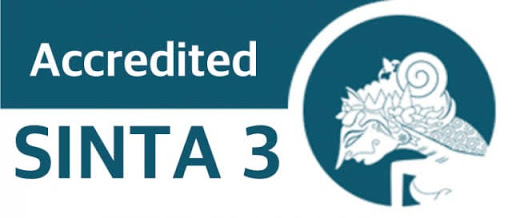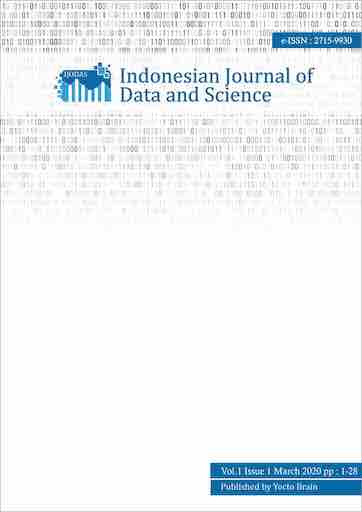Analisis performa metode Support Vector Machine untuk klasifikasi dataset aroma tahu berformalin
Abstract
Bermunculan adanya kasus penyalahgunaan formalin sebagai bahan pengawet untuk tahu dan ketersediaan cara deteksi kandungan formalin yang tergolong tidak praktis dan membutuhkan tenaga ahli khusus, Penelitian ini bertujuan untuk melakukan analisis performa suatu metode. Pengolahan data tersebut digunakan untuk memprediksi terdapatnya kandungan formalin pada tahu melalui aroma yang dikeluarkan. Teknik klasifikasi yang digunakan yaitu dengan menggunakan pengukuran performa (Accuracy, Precision, Recall, dan F-Measure) menggunakan Metode Support Vector Machine. Inputan yang digunakan yaitu atribut data aroma tahu berformalin, dan tidak berformalin. Hasil penelitian ini menunjukkan metode SVM mempunyai kinerja yang cukup baik. Berdasarkan hasil pengujian menggunakan confusion matrix didapatkan hasil uji performa Metode SVM accuracy 67%, precision 69%, recall 67%, dan f-measure 66% dengan Nilai K=5.
Downloads
References
BPS, “Statistics Indonesia,” 2020.
L. Vinet and A. Zhedanov, “No Title,” J. Phys. A Math. Theor., vol. 44, no. 8, pp. 1–8, 2011, doi: 10.1088/1751-8113/44/8/085201.
S. Kesen, “Characterization of aroma and aroma-active compounds of Turkish turmeric ( Curcuma longa),” J. Raw Mater. to Process. Foods 1, pp. 13–21, 2020.
S. Hastuti, “Analisis Kualitatif Dan Kuantitatif Formaldehid Pada Ikan Asin Di Madura,” J. AGROINTEK, vol. 4, no. 2, pp. 132–137, 2010.
P. L. Terranova, Peraturan Menteri Kesehatan Republik Indonesia Nomor 1168/Menkes/Per/X/1999. 1999.
M. Syarfaini, & Rusmin, “Analisis Kandungan Formalin Pada Tahu di Pasar Tradisional Kota Makassar,” J. Kesehat. Masy., vol. 7, no. 1, pp. 1–11, 2014.
D. Arziyah and L. Yusmita, “Analisis mutu tahu dari beberapa produsen tahu di Kota Padang,” J. Teknol. Pertan. Andalas, vol. 23, no. 2, pp. 143–148, 2019.
A. N. Khormarudin, “Teknik Data Mining: Algoritma K-Means Clustering,” J. Ilmu Komput., 2016.
S. Heni and A. I. Gufroni, “Penerapan Data Mining Dalam Pengelompokan Penderita Thalassaemia,” J. Nas. Teknol. dan Sist. Inf., vol. 3, no. 2, pp. 299–305, 2017, doi: https://doi.org/10.25077/TEKNOSI.v3i2.2017.299-305.
N. H. Farhat, “Photonit neural networks and learning mathines the role of electron-trapping materials,” IEEE Expert. Syst. Their Appl., vol. 7, no. 5, pp. 63–72, 1992.
P. A. Octaviani, Y. Wilandari, and D. Ispriyanti, “Penerapan Metode Klasifikasi Support Vector Machine (SVM) pada Data Akreditasi Sekolah Dasar (SD) di Kabupaten Magelang,” J. Gaussian, vol. 3, no. 8, pp. 811–820, 2014.
W. Purnami, A. M. Regresi, and L. Ordinal, “Perbandingan Klasifikasi Tingkat Keganasan Breast Cancer Dengan Menggunakan Regresi Logistik Ordinal Dan Support Vector Machine ( SVM),” J. Sains Dan Seni Its, vol. 1, no. 1, 2012.
V. Sofia, I. Atsushi, and R. Anca, “Proceedings Of The Twentysecond Midwest Artificial Intelligence And Cognitive Science Conference,” MAICS, vol. 710, pp. 120–127, 2011.
C. Schaffer, “Selecting A Classification Method By Cross-Validation,” Mach. Learn., vol. 13, no. 1, pp. 135–143, 1993.
A. Fitria and H. Azis, “Analisis Kinerja Sistem Klasifikasi Skripsi menggunakan Metode Naïve Bayes Classifier,” Pros. Semin. Nas. Ilmu Komput. dan Teknol. Inf., vol. 3, no. 2, pp. 102–106, 2018.
H. Azis, F. T. Admojo, and E. Susanti, “Analisis Perbandingan Performa Metode Klasifikasi pada Dataset Multiclass Citra Busur Panah,” Techno.Com, vol. 19, no. 3, 2020.
L. Nurhayati and H. Azis, “Perancangan Sistem Pendukung Keputusan Untuk Proses Kenaikan Jabatan Struktural Pada Biro Kepegawaian,” Semin. Nas. Teknol. Inf. dan Multimed., pp. 6–7, 2016.
M. M. Baharuddin, T. Hasanuddin, and H. Azis, “Analisis Performa Metode K-Nearest Neighbor untuk Identifikasi Jenis Kaca,” Ilk. J. Ilm., vol. 11, no. 28, pp. 269–274, 2019.
H. Azis, “Klasifikasi Penyakit Jantung Menggunakan Metode K-Nearest Neighbor,” Indones. J. Data Sci., pp. 1–4, 2018, doi: https://doi.org/10.33096/ijodas.v1i1.3.
S. Sahar, “Analisis Perbandingan Metode K-Nearest Neighbor dan Naïve Bayes Clasiffier Pada Dataset Penyakit Jantung,” Indones. J. Data Sci., vol. 1, no. 3, pp. 79–86, 2020, doi: 10.33096/ijodas.v1i3.20.
L. B. C. Tanujayaa, B. Susanto, and A. Saragiha, “Perbandingan Metode Regresi Logistik dan Random Forest untuk Klasifikasi Fitur Mode Audio Spotify,” Indones. J. data Sci., vol. 1, no. 3, pp. 68–78, 2020.
NIRMALASARI, “Analisis Performa Metode Naïve Bayes Classifier Dan Cross Validation Pada Data Penyakit Cardiovascular,” Indones. J. data Sci., 2020.

Authors retain copyright and full publishing rights to their articles. Upon acceptance, authors grant Indonesian Journal of Data and Science a non-exclusive license to publish the work and to identify itself as the original publisher.
Self-archiving. Authors may deposit the submitted version, accepted manuscript, and version of record in institutional or subject repositories, with citation to the published article and a link to the version of record on the journal website.
Commercial permissions. Uses intended for commercial advantage or monetary compensation are not permitted under CC BY-NC 4.0. For permissions, contact the editorial office at [editorial email/contact form].
Legacy notice. Some earlier PDFs may display “Copyright © [Journal Name]” or only a CC BY-NC logo without the full license text. For the avoidance of doubt, authors hold copyright, and all articles are distributed under CC BY-NC 4.0. Where any discrepancy exists, this policy and the article landing-page license statement prevail.














